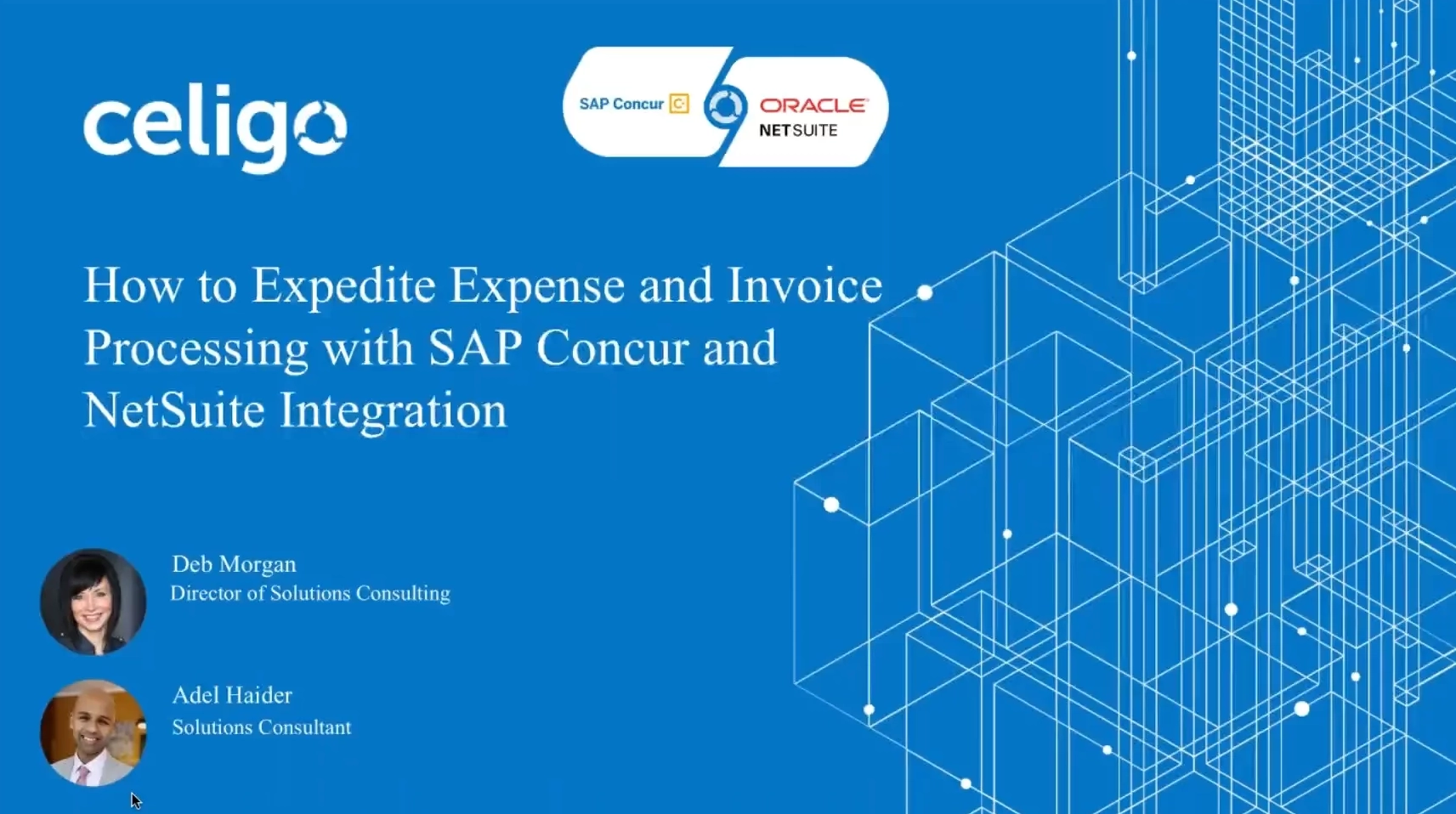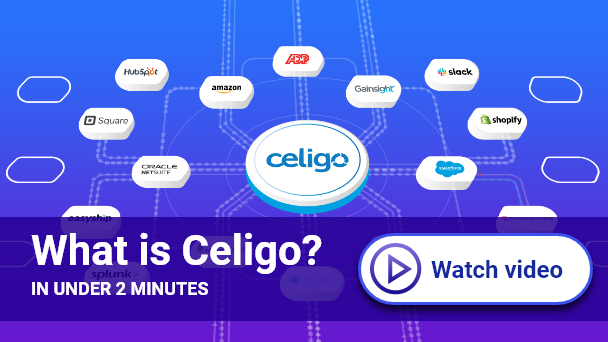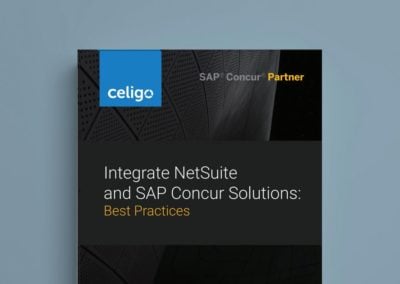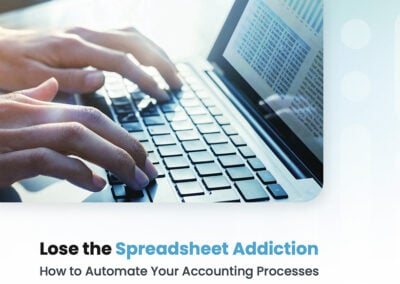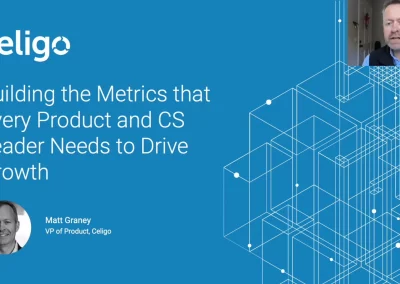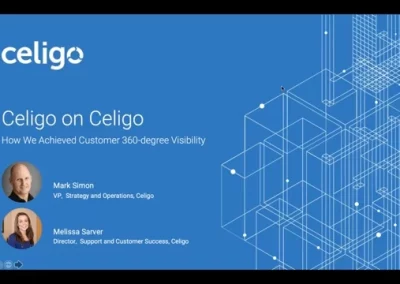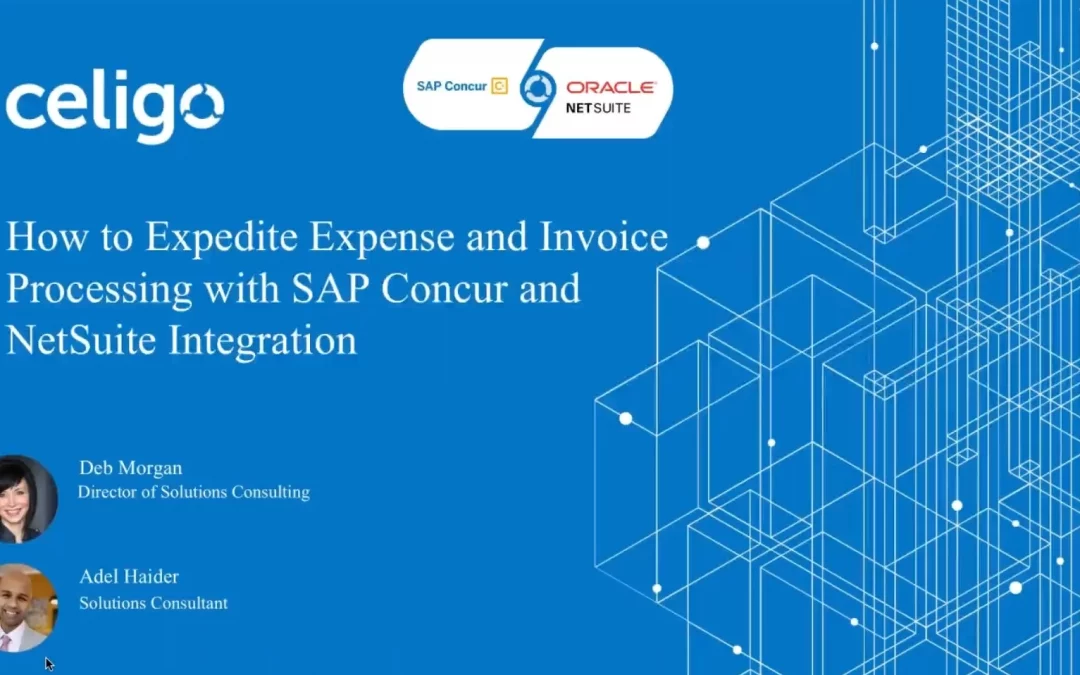Hello, everyone. Welcome to our webinar today. My name is Ebru, and I’m a product marketing manager at Celigo. And I’m here today with Deb Morgan, Director of Solutions Consulting. She has many years of experience in finance and accounting. And also we have here our solutions consultant, Adel Haider. And today we’re going to talk about how to expedite expense and invoice processing with SAP Concur and NetSuite integration. So now I will be handing it off to Deb. Hello, everyone, thank you for joining. So I will take just a quick minute to give you a little bit of my background. I actually joined Celigo myself a little over three years ago, and I was actually a customer of Celigo’s for my own banking integrations and some additional other in points, and now I’ve been here three years helping others with their integration. And I just wanted to take just a few minutes to talk about Celigo. So it’s Celigo at a glance here. I just, this is one of the things that really attracted me to Celigo personally, was instead of just coming for solutions that are solving one particular problem, we’re actually looking for– I was looking for a platform, something where I could have all of my integrations managed and maintained in one platform. And that’s really what brought me to Celigo. And at a glance here, you’re going to see we have over 3,000 customers. We are an integration platform as a service. It’s an iPaaS platform. We were founded in 2005. And we are a global company, and we have our corporate offices in San Mateo, California. And we are in the Gartner Magic Quadrant. And hopefully, you’re familiar with that as well. We’re very proud of that. And we are vertical agnostic. So really, we don’t support just a single vertical like e-tail. We really are across all verticals. And we are the best in class integration into applications such as SAP Concur and NetSuite, which is what we’re covering today. But in addition to that Salesforce, Slack, etc. So these are just a few of our customers that we are really happy to have here at Celigo. So the next thing I want to cover here is, just to touch on that just a little bit further here. I mentioned that we’re an iPaaS platform that we’re not just solving a single integration. You could truly manage all of your endpoint integrations on one platform. And take a look through here– Adele is going to show you a little bit more about the actual marketplace online. But as you can see here, there’s a lot of different endpoints here that not only could help you manage your expenses, etc. but they’re really across the board. And today we’re going to be discussing SAP Concur and NetSuite, but we have so many other integrations here. So just take your time and look through that. Adele is going to give you a little bit more info later. And one of the things you’re going to notice is, even if you’ve looked through this, and you’ve looked through our marketplace and you don’t see a product that you’re into– that you would like to integrate with, just know this is really an anything to anything platform. So as long as we have a way to grab the information, and as you can see here listed at the bottom, we do a lot of other things. API’s are very common, but we can also do HTTP, SFTP, etc. So just keep that in mind. This is really to support all of your integration needs. Today we’re going to talk about just a little bit more about sync management as it relates to the iPaaS platform. You’ll see here there’s SAP Concur here as a hub. There’s a lot of different tools that your teams might be using across the board. As I mentioned, really thinking about this, instead of just looking for single solutions. Really go out and think about how to streamline all of your integrations onto one platform. Makes it much easier to manage, much more cost-effective to do that. And, today we’re going to be talking about how you could standardize your spend management across your organization. And, on that particular one, what we’re going to talk about here, is Concur, as you know, you’ve invested, or either you’re considering investing in Concur, to reduce your expense claim processing. It’s going to ensure that all of your expenses have fallen within the company policies, and [inaudible] making sure that your expense reports are easy to review and approve. And, so with that, you also want to have the integration. So, that’s going to completely streamline and automate an end-to-end process. And, we’re going to go into a few more of these in greater detail here throughout this demo. But, essentially, this is really just to summarize. We’re looking at integrating across your entire organization, to streamline all of your spend management. One of my slides is missing. Let’s see, here we go. Maybe it’s going to work. There we go. All right. So, I want to talk about what this slide represents. So, obviously there’s some really big advantages here. And when you’re looking at Concur as a expense management tool, some of your typical management expense processes are, obviously, that your employees are going to submit their expense reports. You’re going to do all of your approvals through them, your manager’s either going to approve them or reject them. And, then you’re going to be able to go through and your book-taking teams will now need to go in and take that data, manually if you have no integration, from Concur. They’re going to be able to go in and manually upload that. And what we’ve done here, really, is we’ve kind of given you a little sample here. And these numbers, of course, unfortunately, are not the winning lottery numbers. But, they do represent the time and the money savings for integrating Concur and NetSuite. Now, we’ve based this off of a $25 per hour person that would be processing these. So, if your person is higher or lower, you can easily extrapolate these same kind of savings in your organization. And, as a side note, this is much better odds than winning the lottery. So, just wanted to point that out as a little fun piece of information. But, the goal here is not only to streamline and improve [inaudible] efficiencies and avoid double entry and manual efforts, it’s also meant to save your team money as well. So, let’s go to this next slide. Now, there’s some challenges. Of course, everybody on this call knows, that have been in this kind of situation, they know that there’s a lot of challenges with expense management, right? And so, I wanted to point out a few things. One, you don’t really have visibility into how funds are spent, if you don’t have expense management software or integration. Manual data entry is slow and prone to errors. We are human beings, so we will make mistakes. One of the big things for me personally, when I implemented Concur, was I was looking for something that was scaleable. My company was growing really, really quickly. Okay? And then also, I did want to point out, there’s some other really big challenges too. And that is, that really the time that it takes to get these things done and through the process. So, there’s a lot of people that are touching this, waiting on things, etcetera. So, the the typical process, I guess, that you would see in your kind of expense management life cycle would be that first, your employees are going to submit their expense reports, and then there’s going to be a level of approval for that. And then the AP is going to be getting the information to process and this is where if you don’t have integration and somebody’s downloading this information out of Concur to try to get it into the system for reimbursement, right? And then they’re getting it scheduled for reimbursement on the next cheque runner to pay our employee reimbursement runs. And then there’s all this bookkeeping, right? Finance and accounting needs to do updates, etc. And companies frequently add different departments and they add classes, locations, and other reporting segments, and really there’s just a lot of manual effort required across the board in getting your expenses visible and approved. Okay. And so we’re going to come down to this next slide. Now, what we want to talk about is really what is Celigo’s role in helping automate this? And so imagine for now you’ve already made this investment in Concur and you’ve really gotten this streamlined, right? And there’s some big advantages to having Concur and I just want to summarize a couple of the big ones really quickly before I go into how. And Celigo solves for the net stuff, which is really hands-off automation. But essentially, all of your processes are streamlined and also your employees are all following a company policy for expense levels and expense amounts that are authorized and you don’t have inconsistencies across departments where one department is getting reimbursed for more higher expenses on hotel costs or flights or meal reimbursements. And so just really getting everything standardized across the board. And so you’re already one big step ahead in terms of getting that done with Concur. Now, the next thing is how do we go about providing also internal controls? And if you think about it, if I have gone through all these approvals through Concur and my managers have reviewed them and even finance and accounting has reviewed, and now you have an individual that’s downloading data. And so there’s still an internal control gap there where someone could still potentially go and then change that information. And so really having it hands-off and once it’s gone through actually having that integration, the hands-off is really really good for internal controls. And the way that Celigo solves for this is we actually go in and we have created a pre-built template. And it’s a quick-start template and so you’re never starting from scratch and it covers all of the most basic things that we’ve talked about here. And I did want to point out that for this template and for these expense flows, currently, they support our Concur standard and professional editions and we will be offering support for the corporate edition starting in July of 2020. And you’re going to see here that we’ve kind of already pre-built the most common ones and so let’s talk about a few of those. And so we’re syncing users and employees between the two systems and companies and customers and all of your SAP Concur lists like departments and you’re other segments that you need to have to have pushed. And we’re actually syncing over your expense reports between Concur and internet suite and we’re syncing all the different amounts, of course, and any memos and categories. And so what categories of expense? I personally know that even when your company is adding new departments and categories, it’s usually manual and you’re having to do it in two places, right? You would have to do it in that suite and Concur. And so in this example here, we’ve really covered all the most common requirements to be hands-off and so when you’re doing it in one, it’s going to sync over automatically. I do want to point out that there’s one thing that is not on this slide and that is the purchase order flow. We will actually be adding that in August of 2020. And that is only for the expense management flow. So, as of August, we will see another flow down here called the purchase order. Okay? So we are going to be covering these. We will demo these. Adele is going to walk you through some of these examples here. But just know that, again, this is the most-common-use cases, but there is a real advantage I mentioned earlier about having this on an iPaaS platform. An iPaaS platform really does allow you to have a lot of flexibility. You can go in and you can customize, if you need something custom that’s not captured. That’s a real advantage. Now, I want to talk about just briefly– everybody’s probably familiar with most of these but this is the real benefit of the Concur expense integration. Not only are you going to expedite your expense payments to your employees, right? Everybody wants to get reimbursed in a timely manager so things are not languishing. You are also, as I mentioned earlier, ensuring compliance with company policies. Is everybody falling within a max cap on an expense category? Also, I have to tell you that, many times when we were doing this, we found a review of the expenses from the past. A lot of kind of personal expenses kind of slipped through there. So really having that streamlined and having consistent processes and easy visibility for reviewing and approving these was really, really essential. Now, the other thing is really about reporting. Right? At the end of the day, what does it look like for me? Do I have, as a company, visibility into how money is being spent, how the funds are being allocated across the board? So having really good reporting is very essential for not only planning and forecasting but really just getting a better understanding of how funds are being managed within the company. And again here, making healthy business decisions with real-time visibility into the data. Information coming out of accounting and finance today needs to be timely. It needs to be really, really current. Things move really quickly. So having good visibility into your cash position and any pending expenses is really, really important. And last but not least is minimizing accounting errors. As I had mentioned earlier as well, people do make mistakes when we are double-keying, we’re double-entering, we’re downloading, we’re importing. If there is no integration, you now have to pretty much reconcile those systems. Right? To make sure that everything has been captured correctly. So really, that’s really the key benefit here for expenses. Now, there’s two components to the Concur Integration that we will be covering today. The first one that we just mentioned was around expenses. However, there is also going to be some flows that are going to be covering your invoice management. Right? Very, very similar process where, in this example, a vendor invoice is received. This is coming from usually via an employee that has received an invoice. They will be going through and having the same kind of approvals. Not only their manager or department levels, depending on the kind of thresholds, they will also be needing to have all of the AP teams process these and get them cued up for payments. The actual reimbursement, of course, and then people just managing everything, including where are the copies of receipts. Things like that. So when you are doing Concur, not only is everything streamlined, it is also reducing a lot of manual paper effort, and it is going to streamline your processes and procedures. Now, you will notice here, it is very similar to the expense management is if you don’t have automation or integration here, you don’t have visibility into how all the funds are being spent, manual efforts, and again, [inaudible]. So pretty much the same as your expense management. Now, you’ll see, just like on the expense management side, we have pre-built a quick start template, and we’ve covered all of the most common flows that are required to handle your invoice requirements for integration between [inaudible] and Net Suite. And the flows that are included with this product are syncing your users and employees. Very similar to the prior one. You’ll see some differences towards the bottom. Users and employees, customers and companies. We’re syncing vendors, and we’re also doing lists and departments. In this example, we’re sending a vendor invoice, and we’re bringing that into Net Suite as a vendor bill. And of course, amounts and categories. So these are really the most common flows that we see from a Net Suite Concur integration requirement where invoices are concerned. And as I mentioned previously, on the expense management slide, if you have something that is outside of us, and you need us to add an additional flow, that’s what nice about having integrator [inaudible] platform solution. So it’s very, very nimble. One other thing I did want to touch on briefly is really that you’re going to see when [inaudible] shows the goal here with all of our products regardless of what the end points are is that your companies are going to change. Changes are going to need to be made. It’s very easy for you to do these on your own, or you have our support team that you can reach out to for help if you need help. But really, we have approached this as we really want to make integration simple. So it’s not going to be something that’s difficult for you to maintain. We’ve really made this really simple, but it’s very powerful, the actual platform. So the last thing I want to cover before we jump into a demo here is really just talking about the key benefits. They’re very similar to the expense management. Maybe you don’t even need the invoice management. But I just wanted to cover some of these benefits. We’re going to process your invoices faster. Your vendors are going to appreciate that. They’re also going to be able to– maybe you’re able to negotiate better terms with your vendor if you’re able to pay faster. It really kind of depends on your business process. We are going to reduce your spending by paying your vendors accurately. I don’t know about you, but in my team, and in the past before I even had Concur integration, I found out there were sometimes things accidentally submitted twice for reimbursements or a vendors was paid twice, so really reducing any errors that are being made, not only to reimburse your employees, but also your vendors. And again, wanting to see how your funds are being spent, really looking at the categories of spend. If you notice that you’re spending a lot of money with a particular vendor, you’re able to maybe go out and renegotiate some really good rates or terms with those vendors, especially if you have good visibility into your trends that you’re spending. So having that data that you could share with them is really, really useful. And then, essentially making any good business decisions with real time visibility. Right now, as you know, cash is king everywhere, so having really good visibility into your cash positions or into your expenses that are coming down the pipe that are going to impact your cash position is super, super critical. So just getting your employees to submit these expense reports and getting these vendors to submit these invoices in a timely manner is super, super important. So you’re actually going to be able to see even vendors that are lagging and taking a long time to get invoices in as well. So you could really reach out to them and work with them on things like that. And of course, minimizing accounting errors, double entry, just keying errors, downloading internal controls again on things like this. If you’ve already approved it in Concur, the last thing you’d want is for someone to go in and pay a vendor more than what was approved. So these are really just a good summary of all the different things that we would be covering for you in these pre-built integrations. So, to summarize here, we’ve really covered not only the expense side of the house from SIP Concur and Net Suite, but we’ve also got flows that support any needs that you have for bringing invoices in from Concur into Net Suite. So I think what we’ll do next here is we are going to move into a demo here really quickly. [inaudible]. [silence] Yeah, thank you for that, Deb. So, good afternoon, or rather good morning, everyone. It’s good afternoon for me, as I’m based out of London. We might have some people from different parts of the world. So, just to continue here in the momentum, let’s get straight into our demo, and just as a recap, what we’re going to look at is what Deb had explained before and walked you through before as well is the expense management side of things and the invoice management side of things. So from our expense here, we have a dummy Concur account set up for us today. So let’s go ahead and create an actual expense and see it flow all the way into NetSuite. In the interest of time and because I’m being a little bit lazy, I’ll just make a copy of one of my existing ones here, but you will definitely see the gist of how things actually work here. So let’s go ahead and make a copy of this claim. I’m going to give it a new name. Let’s give it a demo claim one. Okay. And what we’re going to do here is also make some adjustments to this claim. Let’s go ahead and just change the amount just so it doesn’t look exactly the same here. So let’s change this to 500. There we go. And similarly we’re going to update the itemization aspect of things as well just to keep things in line, of course. Otherwise we won’t be able to save or even register the claim. Okay, so we’ll go ahead and save the itemization. And last but not least, we save the expense as well. Okay. So now we have our claim ready to submit. We’re going to go ahead and do that. Okay. And there we have it, the claim has been submitted. Now that’s as far as the user needs to be concerned about that. And what we’ll do as well – and pay close attention to this – is we’re going to take the report ID itself, the unique identifier for this claim which is generated in Concur itself, okay? Now, that’s all the user needs to do. But for those of you who are unfamiliar with how Concur works on the back end, there is a process with automation already in place which essentially gathers the data, exports it, and generates an export for that on a regular basis. So we’re going to simulate that happening. And usually it’s set up to run perhaps once a day or perhaps two or three times a day, but we’re not going to sit here and wait for that. We’re actually going to trigger it and see it actually happening. You’ll see here it has an appropriate name given what we’re talking about today. We’re going to go ahead and execute this from within Concur. And when we have a look at the run history, we’ll see it’s just finished executing, and there is one record which is the one we have just created. But now similarly let’s go into the platform itself to look and see what’s actually happening there. Similar to that– and here are all the flows and we’ll come back to them in a moment. Similar to how Concur actually works, we also have a scheduled mechanism which is something you can define here in terms of the frequency, anything from once a week to once a day, down to every 15 minutes, but a typical one would probably be perhaps once a day or even twice a day. So what we’re going to go ahead and do is also simulate the execution here which is something particularly useful because you can actually choose the time as well. So if you have a backlog perhaps of expenses which you need to migrate over from Concur to NetSuite, you can do that through here without having to go through the process of manually doing as [Deb?] was describing as well. So now we execute that, and here’s where we start to see how the platform actually works as well. We have a dashboard here which shows you all the previous executions as you can see here as well together with the current ones. So it’s showing you the jobs which are executing. You have some statistical information such as successes, number of records which are being ignored, and also very important is any errors that may have happened. Now this is not a dashboard you’d be living in so you don’t have to come and see it every day, but it’s definitely useful to analyze in the event if something has gone wrong for any particular reason. And later on in our demo we will see what you do when there is an actual error and how you actually get notified of that, how do you configure the platform to notify you in the event of an actual error. And as you see here, the extraction of the information from Concur has actually completed, and what the platform is doing is now writing or posting the information into NetSuite so creating the necessary expense report together with the itemization that we have defined there as well. And there you go. Here is the process now coming into play. And once that’s done we will then move over to NetSuite. There we go. Now that’s done. We’ll move over NetSuite and we’re going to search for the actual ID of that expense report, remember, from Concur, and here you go, you can see there listed. We drill down into that. We see the idea of the report, the user to which it pertains, as well as the details such as the Parapace, which has been prefilled, and the amount, as you saw, that we made the change there. Now, this only has one item for simplicity, but you can see how further items can be brought in quite easily as part of that process. Okay? And that really illustrates how easy it is to have the expense management put into Concur and how it moved over to NetSuite, something which probably takes you many hours a day. I was illustrating and pointing to and alluding to as well, something which is automated for you and completely hands-off. The only touchpoints that we did there were really to simulate the backend actually executing things on a daily basis. Okay? Now, if we move on to our second use case, which is that of the invoices, we’re going to do a similar process. Again, so we’re going to go back into the user itself or his or herself and we’re going to create an invoice. Now, similarly to that, in the interest of time, just keeping things simple, would rather make a copy of an existing invoice and make a bit of a change to it as well. So go ahead and make a copy of this one. And we’ll make some changes to we know that it’s the same one that we’re actually seeing here is the same one in that suite as well. So let’s go ahead and change this here. Ane we’ll change the invoice number as well. Now, pay close attention to that because we will be using that to actually do the search n NetSuite, similar to how we did for the expenses as well. Now, one last thing I will do is update the particular itemization as well and also pay close attention to the type here that’s been listed as [inaudible] that’s something which has also migrated across over from Concur into NetSuite as part of the synchronization. Okay? Now, we’re going to go ahead and submitter invoice here. And now that is done. It’s in the approved state. Now it’s only pending payment. Similar to what we did before, this is all the user need to do. We’re going to go now back into the backend and simulate the process or trigger off rather the process of the extraction and generation of the extract, which we can then use to import into NetSuite. Now, again, the reason we’re doing this is simply because, on a regular basis, this would be running perhaps once a day or for multiple times a day, but we don’t want to wait until it actually does execute, so we’d rather execute it straight away. Olay? Now that that’s done we go and view the history and again we’ll see that it has executed successfully and there is a record count one, which is the specific invoice that we have just created. Moving back to the platform, we’re going to go ahead and go to the invoice side of things. And just to point out one thing as well, as Deb was mentioning before, excuse me, we have support for the standard [inaudible] and the professional addition, as well, and these all are separate flows. We’ll be including support for the corporate edition soon enough, as well. Now, similar to that to the previous one for the expenses, this also runs on a schedule which is configurable in a similar fashion as well. Now, for our purposes, we are going to trigger it manually. And again, you’ll see the same possibility to change the date here, date and time, so you can import invoices which are back-dated, as well. Okay? You’ll also notice while this is executing how uniform the platform actually is and quite user-friendly, if I might add, so it’s– even though it’s a backend, it’s a middleware. It’s something which doesn’t have to be monitored. It’s meant to be a set-and-forget type of system. However, it is something quite friendly and visually appealing to use, which is very, very important because if– as Deb said it before, if it’s– if any requirements are– to make adjustments or changes to the mappings, for example, or even introduce a new step, it is intuitive to do so, and this is very important to remember because sometimes that can be a challenge and integration really needs to be fundamental in how it works. It is supporting a backend process in the end. And there we have it. In this case, the invoices have been– or this particular invoice has been imported successfully, so we’re going to go over into NetSuite and plug in our invoice number or invoice specific unique identifier there, and there we have it clearly identified there, and you’ll notice here the information, which we noticed before. So the reference number, the specific total amount, and then all the way down here, we have the listing. In this case, again, only one particular item, but you’ll see here the advertising account as well as the amount that we listed for it. And there you have it. There’s an example of the invoices being moved over from Concur into NetSuite. Again, a process which will take you quite some time if you’re doing it manually but, in this case, the system does it completely for you. You’re not having to lift a finger apart from just creating the invoices in Concur as well. Now, if we go back into the platform, the backend, just to show you what other flows are there and this just highlights what Deb had mentioned, as well. And it showed it before in the slides, but you see here a number of different flows available such as the lists, which are very, very important and the departments and, more importantly as well, the companies which would be created Concur, migrating them over to NetSuite, as well as the employees that could be done as well. And if we look at the invoices side of things, the similar thing as well for the companies to customers. Payment is what we’ve actually seen. The vendors and the departments, as well, and they all look pretty much the same. They all just need to be switched on and they can immediately be scheduled to start executing. Now, if you recall, as I said before, [inaudible] we’ll be seeing how the notifications element works and this is really where this part here plays an important role because you can choose which flows, which pipelines, to be notified of in the event of an actual error. A typical example is to be notified in the event of an error in your payment request, in your creation of the vendor bills. The reason being this is a critical part. If that’s gone wrong, then that can cause havoc on the NetSuite side if you don’t have the vendor bill or it’s not been created correctly. So that’s really important to be able to get notifications, in this case via email directly to your inbox, in the event that something has gone wrong within the platform, be that technical or functional error, as well. Now, aside from, obviously, Concur and NetSuite, there are some other integrations that we have. Quite a few, as Deb had showed a subset before, as well, in the beginning of our webinar, but here’s just a flavor, just a tip of the iceberg, of the integrations we have and these are particular to NetSuite, but just to give you an idea of what’s actually available for you. It’s quite a few options there that you can request and also install as part of templates we do have. And one particular interesting example, if I may go down to here, is the connection to the Ariba network as well. So there’s also the possibility of integrating into there as well. Now I think at this point, what I shall do ladies and gentlemen, is hand this over now to Ebru if I may. Let’s see. Thank you, Adel. Let me share my screen here. Okay. Yes, so I just want to remind everyone, if you have any questions, so please type them in the chat window and we will be answering them shortly. So you can visit our website at celigo.com. And actually, we are offering free accounts so you can click to try for free and get your free account with limited number of clothes and start using our integrated trial platform immediately. And then also, you can go to our marketplace and browse our existing integration templates and integration applications. And then next I would like to let you know that we have another webinar coming up. It’s for NetSuite and SAP Ariba network integration. So we will be discussing with experts from SAP Ariba and our customer Amigo Mobility on how integration can help buyers and sellers. Again, you can sign up for this webinar on our website under resources. And this brings us to the end, so now we’ll be taking some questions. So before that, I would like to remind you all, if you have any questions after today’s webinar or if you would like to talk about your integration challenges, your use cases with SAP Concur and NetSuite or maybe some other applications, you can email us at
[email protected] or just simply visit our website, celigo.com and contact us through the contact popup window you’ll see there. So now let’s see if we have any questions here. So first question is how are the flows scheduled? Are they real time? I think that might be a question for me. So as we saw in the demo, the flows in particular that we were discussing are scheduled. So you can choose the frequency that you want them to be executed. Anything from once a week, for example, down to 15 minutes. And it will depend on the use cases that you particularly have. It’s quite common that in expenses and invoices you might want to have them, perhaps, once a day or twice a day depending on, again, your specific requirements. But you can go down to, I think, 15 minutes, for example. Okay. So there’s another question. How is this different than a point-to-point integration? I think I’ll take this one as well. Yeah, I can take it too [laughter]. No, it’s fine, it’s fine. So the key thing to remember about the difference between this and a point-to-point integration is with a point-to-point integration, there is nothing happening in the middle. There is no middleman or middle [inaudible]. Now, the main disadvantage of that is when something goes wrong for example, you don’t really get visibility of what’s actually happening. You have to diagnose it from either one system or the other or you need to get the experts or the people who built the integration to have a look and see how or what’s actually going on. With a middle [inaudible], you have one central point where you’re managing all of your integrations. Now, today we discussed [inaudible] net speed, but it’s definitely the case and in our experience, we have plenty of examples where the landscape of integrations of a particular enterprise or organization involves and includes much more than just two systems. And having to manage that on a point to point basis can be quite cumbersome, very expensive, error-prone as well, and can introduce a lot of complexity. Okay, great. So one question is do I need an IT person or team to manage and maintain the integration? And so I can take this. So our platform, it is built to be used by both business and technical users. And we have a very intuitive user interface. And on top of that, we provide easy to use dashboards for monitoring, troubleshooting, and managing the integrations. So basically, any business user should be able to manage and maintain their integrations themselves. And actually, we have many customers today who are just finance or accounting professionals and they are managing the integrations without any IT support. And I see there is one question here related to pricing. It says, “Is your pricing based on endpoint to endpoint? Such as a certain price for two endpoints, in this case [inaudible] and net speed.” So for any questions related to pricing, we can address them offline. But yes, our pricing basically depends on the number of endpoints you are using. Let’s see. Okay, I think this is a good question for Adel. Does [inaudible] allow for not only mapping configuration, but also enabling complex transformations of data running from system to system? In short, yes. And depending on how you want to do that or depending on what you want to do that, you have several ways of doing it. You do have a mapping mechanism in place. It does work very, very well and it is something that our teams leverage on a regular basis, on a daily basis. Now, if you do want to do some more advanced data manipulation, you can tie in and you can plug in javascript execution throughout different parts of the flow of the integrations, which allow you to really dig deep and finetune how the integration works, how the mappings work, how the manipulation of the payload actually works. Okay. Great. And let’s see here. Another question is would I need any IT support to set up the [inaudible] integration templates? Well, I can take this one too. Just with any of these integrations, really it doesn’t require an IT person. I mean, me and my team have implemented a number of these when I was a customer and really the key thing is you want to have a person who is really familiar with that system. So for example, when I did salesforce and net speed or something like that, I had a system admin who really understood all my different fields and my forms. But essentially, you don’t really need any IT resources for any of this. You really need somebody who’s familiar with your process and the documents that we’re going to be creating for you. For example, you expense needs, whatever you’re bringing into net speed. It’s super, super simple and we really have done a lot of the heavy lifting by integrating all the most common flows. So you’re going to find that it’s a wizard-based install just to get the templates installed. And then going from there, everybody has custom fields for example that are very unique to the company. You can actually go in and map that. And I think that on that note if you don’t mind Amber, I think someone had also asked about custom segments, is that right? Yes, that’s correct. Okay, great. So the prebuild integration would depend on the segment that it is. It might not be included in the prebuild already, but we could certainly do that. We can add that. As I mentioned earlier, because we are an [inaudible] platform, it’s super easy to customize. And that’s one thing you might not be able to do if you’re just looking for some other integration that’s kind of prebuilt. There’s not a lot of flexibility in some of those. So I just wanted to point that out as well is if you have custom segments that you have developed that need to be a part of your transactions, some of them might even be supported out of the box. We would just need to take a look at them. But if not, we would be able to support that on our iPaaS platform. Okay, great. Thank you very much, Deb. And so this brings us to the end of today’s webinar. And if you have any more questions, please follow up with us. You can email us at
[email protected]. And we are looking forward to hearing from you, so that you very much[Deb and Adel? for your presentations today. Thank you, everyone. Thank you, everybody. Thank you. Bye
